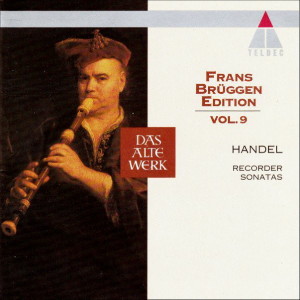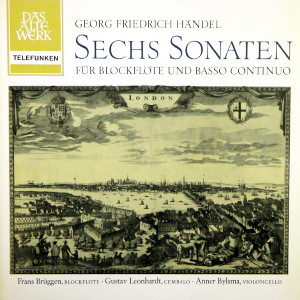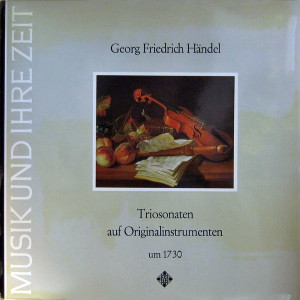 |
|
1 CD -
4509-97471-2 - (c) 1995
|

|
| 1 LP -
SAWT 9491-A - (p) 1962 |
 |
| 1 LP -
SAWT 9559-A - (p) 1970 |
|
| FRANS
BRÜGGEN EDITION - Volume 9 |
|
|
|
|
|
| George Friderich
Handel (1685-1759) |
|
|
|
|
|
| Sonata in A
minor, op. 1/4 HWV 362 -
treble recorder and basso continuo |
10' 45" |
|
| 1.
Larghetto |
2'
45" |
|
| 2.
Allegro |
2'
37" |
|
| 3.
Adagio |
2'
05" |
|
| 4.
Allegro |
3'
18" |
|
| Sonata
in C major, op. 1/7 HWV 365 -
treble recorder and basso continuo |
9' 57" |
|
| 5.
Larghetto |
2'
37" |
|
| 6.
Allegro |
2'
10" |
|
| 7.
Larghetto |
1'
59" |
|
| 8. A tempo di
Gavotta
|
1'
35" |
|
| 9. Allegro |
1'
36" |
|
| Sonata
in B flat major HWV 377 -
[Fitzwilliam Sonata I] treble
recorder and basso continuo |
5' 42" |
|
| 10. [Allegro] |
2'
00" |
|
| 11. Adagio |
1'
18" |
|
12. Allegro
|
2'
24" |
|
| Sonata
in G minor, op. 1/2 HWV 360 - (Sonata a Flauto
e Cembalo) treble recorder and basso
continuo |
7' 56" |
|
| 13. Larghetto |
2'
06" |
|
| 14. Andante |
3'
05" |
|
| 15. Adagio |
0'
47" |
|
| 16. Presto |
1'
58" |
|
| Sonata
in D minor HWV 367a -
[Fitzwilliam Sonata III] treble
recorder and basso continuo |
9' 06" |
|
| 17. Largo
|
2'
09" |
|
| 18. Vivace |
2'
05" |
|
19. Furioso
|
2'
07" |
|
20. Adagio
|
1'
17" |
|
| 21. Alla breve |
1'
37" |
|
| Sonata
in F major, op.1/11 HWV 369 -
(Sonata a Flauto e Cembalo) treble
recorder and basso continuo |
7' 08" |
|
| 22. Larghetto |
1'
52" |
|
| 23. Allegro |
2'
09" |
|
| 24. Alla Siciliana |
1'
19" |
|
| 25. Allegro |
1'
48" |
|
| Trio
Sonata in F major, op.2/4 HWV 389
- treble recorder, violin and basso
continuo |
12' 14" |
|
| 26. Larghetto |
2'
31" |
|
| 27. Allegro |
2'
58" |
|
| 28. Adagio |
2'
32" |
|
| 29. Allegro |
2'
00" |
|
| 30. Allegro |
2'
13" |
|
|
|
|
| Frans Brüggen, recorder |
The instruments |
|
| Anner Bylsma, violoncello
(1-25) |
recorders |
|
| Gustav Leonhardt,
harpsichord (1-25) |
- Hans Coolsma, Utecht
1962 treble [alto] in f' - [1-25] |
|
| Alice Harnoncourt,
violin (26.30) |
- Hans Coolsma (after
Bressan, London c. 1720), Utecht
1962 treble in f' - [26-30] |
|
| Nikolaus Harnoncourt,
violoncello (26-30) |
violin |
|
| Herbert Tachezi,
harpsichord (26-30) |
- Jacobus Stainer,
Absam 1665 . [26-30]
|
|
|
violoncellos |
|
|
- Carlo F. Landolfi,
Milan 1753 - [1-25]
|
|
|
- Andrea Castagneri,
Paris 1744 - [26-30]
|
|
|
harpsichords |
|
|
- J. C. Neupert,
Nuremberg 1932 - [1-25]
|
|
|
- Martin Skowroneck,
Bremen - [26-30] |
|
|
|
|
|
Luogo
e data di registrazione |
|
Vienna
(Austria) - settembre 1969 [26-30]
|
|
|
Registrazione:
live / studio |
|
studio |
|
|
Producer /
Engineer |
|
Wolf
Erichson [26-30]
|
|
|
Prima Edizione
LP |
|
-
Telefunken "Das Alte Werk" - SAWT
9491-A - (1 LP) - durata 51' 02" -
(p) 1962 - Analogico [1-25]
- Telefunken "Das Alte Werk" -
SAWT 9559-A - (1 LP) - durata 44'
21" - (p) 1970 - Analogico [26-30]
|
|
|
Edizione CD |
|
Teldec
- 4509-97471-2 - (1 CD) - durata
63' 40" - (c) 1995 - ADD |
|
|
Note |
|
- |
|
|
|
|
Only four of
George Frideric Handel’s six
sonatas for treble recorder
and continuo were published
during their composers
lifetime (they appeared in
print around 1730).
The two sonatas in B flat
major and D minor remained
in manuscript, their very
existence unknown to
Friedrich Chrysander when he
published volume 27 of his
complete edition of Handel’s
works in 1879. Not until
1948 did the English
musicologist Thurston Dart
publish the two remaining
pieces under the title
Fitzwilliam Sonatas (after
the Fitzwilliam Museum in
Cambridge, where the
autograph scores are
lodged). Dart’s
edition of the D minor
Sonata contained only five
movements, however. Two
additional movements
included in the autograph
score -
an Andante and a Minuet -
were not published complete
until the 1970s, in other
words, after the present
recording had already been
made.
Manuscript studies,
including examination of the
type of paper used by
Handel, show that all six
sonatas were written around
1712. Although they are
explicitly scored for treble
recorder, Handel availed
himself in many of the
movements of what might be
termed a “neutral”
instrumental style that
contrasts with that of
Telemann, who would draw on
his intimate knowledge of an
instrument to exploit its
technique and compass
to the full.
The extent to which Handel
drew on his own existing
reserves may be illustrated
by two examples among many:
in around 1755 he added a
number of orchestral
ritornellos to the F major
Sonata and published it,
otherwise unchanged, as his
Organ Concerto op. 4 no. 5
(HWV 293);
and the opening movement of
the B flat major Sonata was
reused in 1726 in the
overture to Scipione,
while the Sonata’s third
movement is almost identical
to the final movement of the
Violin Sonata in A major HWV
361.
Although all six sonatas are
relatively early works, a
number of them already
reveal the full extent of
Handel’s genius, with subtle
thematic linlw between
individual movements and the
use of tonality to create a
sense of contrast. This is
particularly well
illustrated by the G minor
Sonata, whose fast
movements, while sharing the
same theme, are clearly
differentiated in terms of
their time-signature and
rhythm. The virtuoso writing
of the third movement of the
D minor Sonata sets this
work somewhat apart from the
other sonatas in the set:
listen, in particular to the
way
in which brilliant scales
and broken triads alternate
in the upper voice and bass.
The Trio Sonata in F major
HWV 389
was first published by the
Amsterdam-based firm of
Estienne Roger in around
1750.
Here, too, we
find a totally different
compositional principle from
that found in Telemann's
contemporary trio sonatas.
Whereas the latter took
steps to ensure “that the
second part seemed to be the
first" (to quote his
autobiography of 1759),
it is the recorder that
predominates in Handel’s work,
with the violin reduced to a
subordinate role: in the
opening movement it
accompanies the recorder in
thirds, filling out the
latter’s rests by
harmonising the bass line
and acquiring a distinctive
profile of its own only in
the third and fourth
movements; in the final
Allegro -
cast in the form of a gigue
- it
is again combined with the
recorder.
Martin
Nitz
·····
A brief
history of the
recorder
9.
The recorder between
1750 and 1850
After around
1750 the recorder fell from
favour as the Baroque flute
gained in influence. A
changing tonal aesthetic
affected not only wind
instruments but also
strings, with violent
arguments breaking out
between the advocates of the
gamba and champions of the
cello. In
attempting to defend the
qualities of the gamba in
the face of the cello’s
encroachments, Hubert Le
Blanc, for example, wrote in
his Défense de la basse
de viole (Amsterdam
1740): “The transverse flute
is masculine in tone, since
it is harsh at close
quarters: it is far from
agreeable to be close to the
mouthpiece; but its sound
becomes round and mellow the
further away one goes. The
recorder,
by contrast, [...] is
feminine in tone, tender and
sonorous at close hand and
seemingly resonant."
A totally different attitude
was struck by Christian
Friedrich Daniel Schubart in
his Ideen
zu einer Ästhetik
der Tonkunst, in
which he describes the
situation in Germany in
1784/85: “Flaute doulce. A
flute approximately an ell
in length, made of hardwood.
It has six holes and uses
the French bass clef. The
tone is extremely soft and
melancholic. Its
range is barely two octaves.
This flute will tolerate
only very weak accompaniment
and, by its nature, can be
used only in funeral music,
serenades and notturnos. The
excessively quiet tone and
narrow range of the
instrument mean that it is
now almost completely out of
fashion and is no longer
heard in church or at
concerts. Before the
transverse flute became
popular it was formerly much
cultivated, especially in
Germany; people would play
two such flutes,
accompanying them with a
bass flute, an instrument
that looks much like a
bassoon and is played at the
top through a brass tube.
Such a trio did not sound
bad, but it was too
soporific and seemed not
really suited to the German
spirit."
It must be asked how
well-informed Schubart was:
after all, a recorder with
six holes and a compass of
barely two octaves was far
from common in Germany at
this time. Of some interest,
however, is his comment on
funeral music, a comment
confirmed by Bach’s
cantatas, for example And
his remark that “people would
play two such flutes,
accompanying them with a
bass flute” may have a
bearing on the fact that a
disproportionate number of
Denner’s bass instruments
have survived to the present
day.
Be that as it may it remains
a fact that the recorder had
all but disappeared from the
musical scene by the middle
of the 18th century
surviving into the 19th
century chiefly in the guise
of two members of the same
family the flageolet and csákány;
both of which operate on the
same fipple-like principle.
In
the early 19th century,
amateur musicians could
learn different types of
these instruments: the
“flageolet” or “flûte
harmonique” in Paris, the
“patent single, double or
triple flageolet”
in London, and the “csákány”
or “flûte
douce” in Vienna. The
flageolet is a small fipple
flute with four holes at the
front and two at the back,
with or without keys and a
range of more than two
octaves. Composers such as
Krähmer,
Heberle and Bousquet wrote
for this instrument and even
Berlioz reveals in his
autobiography that he
originally wrote for the
instrument in “Le Repos de
la sainte Familie” from L'Enfance
du Christ.
Peter
Holtslag
Translation:
Stewart Spencer
|
|